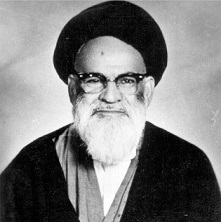Ayatollah Seyyed Mohammad Hasan Mir Jahani Tabatabaee
Ayatollah Seyyed Mohammad Hasan Mir Jahani Tabatabaee | |
|---|---|
 | |
| Born | March 2nd 1902 Isfahan |
| Died | December 17th, 1992 |
| Occupation | Author and shia scholar |
Ayatollah Seyyed Mohammad Hasan Mir Jahani Tabatabaee (Arabic: سید محمدحسن طباطبایی میرجهانی محمدآبادی جرقویهای اصفهانی) (1902-192) was one of the Shi'a scholars in the fourteenth/twentieth century and from Isfahani sadat.
Biography[edit | edit source]
Ayatollah Mirjahani was born on March 2nd 1902, in Isfahan. He was a spiritual figure and a Shia scholar who was mainly known as Mirjahani. He died on December 17th, 1992, and is buried in Isfahan, next to Allameh Majlesi’s tomb. He was one of the descendants Imam Hasan Mojtaba but since his great grandfathers had denied being of Sadat family due to the tyranny of Afghans, he discovered this honor long after he had become a religious figure.
Mirjahani lived a simple life and avoided hypocrisy. To him, holy Imams mattered very much and he showed his hatred to anyone disrespecting Imams quite directly. His attempts against Bahaism were evident and serious.
Education[edit | edit source]
He started learning Quran when he was 5 and by the age of seven he learnt reading, writing, and Quran recitation. After that, he embarked upon learning Arabic literature and finally headed for Najaf, to study under Seyyed Abolhasan Isfahani’s supervision. After returning from Najaf, he settled in Mashhad and then left Mashhad for Tehran.
In Scholars’ Treasure, Mohammad Sharif Razi claims that Mirjahani was an expert in strange sciences, and hadith narration.
Books[edit | edit source]
Although his studies have been mainly in the field of religion and mainly the Shia sect, he has penned some theses on mathematics, astrology, chemistry and old traditional medicine.
As a religious scholar, he has penned more than 50 works, one of the most famous ones is Boka lil-Hussain (Crying for Hussein), the book which he had mentioned in his will to be buried with him.
Another famous work of him is Jannah-al-Asimah which is about the birth and life of Hazrat Zahra (peace be upon her).
Some of his other works are as follows:
- Ravayah As-Samat
- Jannah AL-Asimah
- Navaeb Adhohur
- Al-Buka-lil- Hussein
- Interpretation of Um-ol-Kitab
- Divan-e-Heyran
- Misbah-al-Balaghah
- General Velayah
- Imam, Imamat , and General Features
- Konouz-al-Heakm and Fonoun-al-Kalem
- Asabikat-al-Baydha Fi Nisbat Badh Al-e-Nabi-al-Tiba
- Absar-al-Mustabserin
- Miqlad –asl-Jinan and Miqlagh- al-Mizan
- Zakhirah-al-Ma’ad
- The Thesis for Eternal Fortune
- Lavame-al-Nour Fi Alaem-adhuhur
- Shihab Sagheb
- Rejecting the Misguided Group
- Maghamat-al-Akbariah
- A Thesis on RIza Decrees
- A Thesis on Stars and Astrological components
- A Thesis on Life and Feelings of Hazrat Zeynab
- The Treasure of Delight
- Advising Hadi
- Free Treasure
- Nouresatan Thesis
- Samadiyah Manzoumah